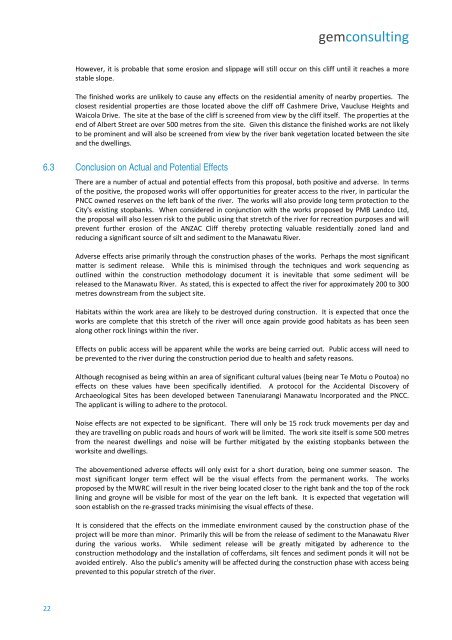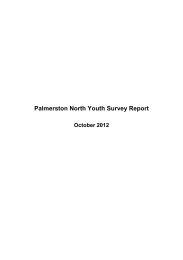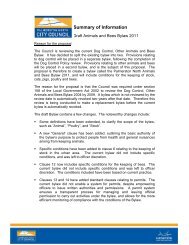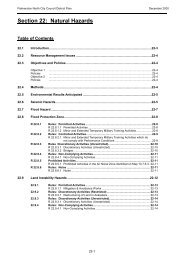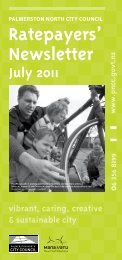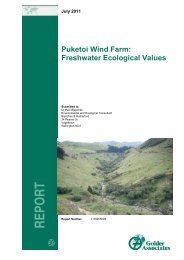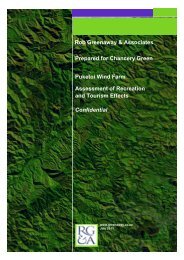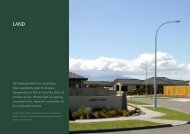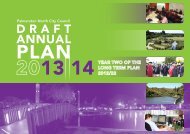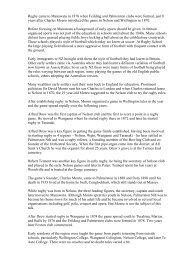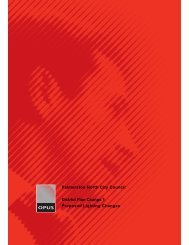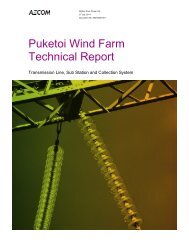Part 1 - Palmerston North City Council
Part 1 - Palmerston North City Council
Part 1 - Palmerston North City Council
You also want an ePaper? Increase the reach of your titles
YUMPU automatically turns print PDFs into web optimized ePapers that Google loves.
gemconsulting<br />
However, it is probable that some erosion and slippage will still occur on this cliff until it reaches a more<br />
stable slope.<br />
The finished works are unlikely to cause any effects on the residential amenity of nearby properties. The<br />
closest residential properties are those located above the cliff off Cashmere Drive, Vaucluse Heights and<br />
Waicola Drive. The site at the base of the cliff is screened from view by the cliff itself. The properties at the<br />
end of Albert Street are over 500 metres from the site. Given this distance the finished works are not likely<br />
to be prominent and will also be screened from view by the river bank vegetation located between the site<br />
and the dwellings.<br />
6.3 Conclusion on Actual and Potential Effects<br />
There are a number of actual and potential effects from this proposal, both positive and adverse. In terms<br />
of the positive, the proposed works will offer opportunities for greater access to the river, in particular the<br />
PNCC owned reserves on the left bank of the river. The works will also provide long term protection to the<br />
<strong>City</strong>'s existing stopbanks. When considered in conjunction with the works proposed by PMB Landco Ltd,<br />
the proposal will also lessen risk to the public using that stretch of the river for recreation purposes and will<br />
prevent further erosion of the ANZAC Cliff thereby protecting valuable residentially zoned land and<br />
reducing a significant source of silt and sediment to the Manawatu River.<br />
Adverse effects arise primarily through the construction phases of the works. Perhaps the most significant<br />
matter is sediment release. While this is minimised through the techniques and work sequencing as<br />
outlined within the construction methodology document it is inevitable that some sediment will be<br />
released to the Manawatu River. As stated, this is expected to affect the river for approximately 200 to 300<br />
metres downstream from the subject site.<br />
Habitats within the work area are likely to be destroyed during construction. It is expected that once the<br />
works are complete that this stretch of the river will once again provide good habitats as has been seen<br />
along other rock linings within the river.<br />
Effects on public access will be apparent while the works are being carried out. Public access will need to<br />
be prevented to the river during the construction period due to health and safety reasons.<br />
Although recognised as being within an area of significant cultural values (being near Te Motu o Poutoa) no<br />
effects on these values have been specifically identified. A protocol for the Accidental Discovery of<br />
Archaeological Sites has been developed between Tanenuiarangi Manawatu Incorporated and the PNCC.<br />
The applicant is willing to adhere to the protocol.<br />
Noise effects are not expected to be significant. There will only be 15 rock truck movements per day and<br />
they are travelling on public roads and hours of work will be limited. The work site itself is some 500 metres<br />
from the nearest dwellings and noise will be further mitigated by the existing stopbanks between the<br />
worksite and dwellings.<br />
The abovementioned adverse effects will only exist for a short duration, being one summer season. The<br />
most significant longer term effect will be the visual effects from the permanent works. The works<br />
proposed by the MWRC will result in the river being located closer to the right bank and the top of the rock<br />
lining and groyne will be visible for most of the year on the left bank. It is expected that vegetation will<br />
soon establish on the re‐grassed tracks minimising the visual effects of these.<br />
It is considered that the effects on the immediate environment caused by the construction phase of the<br />
project will be more than minor. Primarily this will be from the release of sediment to the Manawatu River<br />
during the various works. While sediment release will be greatly mitigated by adherence to the<br />
construction methodology and the installation of cofferdams, silt fences and sediment ponds it will not be<br />
avoided entirely. Also the public's amenity will be affected during the construction phase with access being<br />
prevented to this popular stretch of the river.<br />
22


